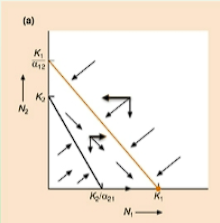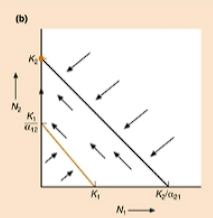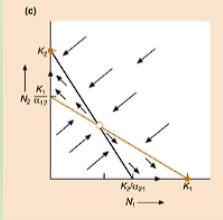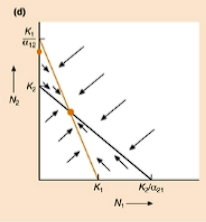BIO 305 - Exam III
1/52
There's no tags or description
Looks like no tags are added yet.
Name | Mastery | Learn | Test | Matching | Spaced |
|---|
No study sessions yet.
53 Terms
Mutualism
any interaction from which all participants gain a fitness benefit.
Facultative Mutualism
when some species can live without their mutualistic partners.
Obligatory Mutualism
when one or both taxa cannot live without the other.
Parasitism
one taxa living within or on the outside of the other taxa.
Foliar Nectaries
specialized nectar-producing structures of the flower.
Beltian Bodies
a detachable tip found on the pinnules of some species of Acacia and closely related genera.
Ecological Community
an assemblage of populations of two or more species occupying the same geographical area at a particular point in time.
Community Ecology
the study of the interactions between and the relative distribution and abundance of species in communities.
Commensalisms
refers to interspecific interactions where one species benefits and the other species is not affected.
Examples of Commensalism?
a common example includes large ungulates (like cattle) and birds, where the movement of the ungulates stirs up insects, upon which the birds feed. Another example are beavers and leaf beetles feeding on cottonwoods. Beaver-felled tree stumps sprout branches with leaves that are more nutritious than leaves on intact trees.
Amensalisms
refers to the interspecific interactions where one species is harmed and the other species is not affected.
Example of Amensalism?
a common example could be ungulates trampling the grass beneath their hooves.
Allelopathy
when some organisms produce chemicals that affect the growth and survival of other organisms.
Neutralism
refers to interspecific interactions where neither organism is affected.
Diversity Index
How we quantify/compare species diversity.
Species Richness
how many species exist in one area.
Species Evenness
how even the number of individuals per species are.
Simpson’s Index
Ds = 1 - [∑ni(ni - 1)] / N(N - 1)
Shannon-Weiner Index
H = ∑pi(Inpi)
What values will the Simpson’s index give you?
Anything between 0 and 1.
What values will the Shannon-Weiner index give you?
Minimum value is 0 with no maximum value, though it is generally no higher than 4.
What does a bell-shaped distribution mean?
The distribution is normal.
What could make a species rare?
Small geographic ranges
Narrow habitat/specificity
Small populations
Productivity
expressed as the amount of carbon/energy transferred from one trophic level to another in a particular area and time interval.
Trophic Level
an organism’s position within a food web.
Primary Productivity
refers to the synthesis of organic compounds from atmospheric or aqueous carbon dioxide, primarily via photosynthesis.
Net Primary Productivity
refers to the rate at which plants (or other primary producers) store energy as biomass after they use some of it for their own metabolism (respiration).
Gross Primary Productivity
everything that an organism is doing in terms of fixing carbon. Some energy is being used up just by existing before there can be excess energy.
Species diversity tends to be (blank) in more complex (i.e., heterogeneous) environments.
Higher.
latitude gradient in species diversity
refers to the observation that species diversity is highest near the equator and declines with increasing latitude.
The Red Queen Hypothesis
proposes that species must constantly evolve in order to survive while pitted against ever-evolving and opposing organisms in a constantly changing environment.
Time since Perturbation Hypothesis
the tropics are older and are disturbed less frequently. Therefore, there are more species in the tropics because there has been more time for speciation to occur and extinction rates are lower due to less frequent perturbation.
Productivity Hypothesis
the most diverse habitats on earth are also the most productive. The idea here is that with more energy to divide among organisms, species will tend to concur in larger populations. Larger populations have lower probabilities of extinction; therefore, extinction rates should be lower.
Environmental Heterogeneity Hypothesis
this hypothesis proposes that there are more species in the tropics due to the increased heterogeneity in terms of habitat/environment, which results in a positive feedback loop.
Favorableness Hypothesis
the tropics are just a more favorable environment.
Niche breadth and interspecific interactions hypothesis
Lots of different hypotheses concerning niche breadth, the interactions among species, and their roles in maintaining higher species richness in the tropics have been proposed. For example, it could be that tropical species are more specialized, and therefore compete less with other species, and this allows for more species to coexist.
Difference in speciation and extinction rates hypothesis
Lots of different hypotheses have been proposed that account for the higher species richness in the tropics in terms of greater speciation rates and/or lower extinction rates.
What is the Lotka-Volterra model for?
It predicts the coexistence of two species when, for both species, interspecific competition is weaker than intraspecific competition. In other words, coexistence is more likely when the magnitude of interspecific competition is relatively low. Otherwise, one species is predicted to competitively exclude the other. In that case, which one “wins” depends on a number of important details.
Neutralism
refers to interspecific interactions where neither organism is affected but can be used to describe interactions where effects on both players are negligible or insignificant.
Facilitation
can (at least partially) ameliorate the effects of things like competition. For example, heterospecific Clarkia spp. compete for similar resources but also help each other indirectly by attracting pollinators to the region in which they occur.
What should predation result in?
All else being equal, it should result in a reduction in prey density and an increase in the density of predators, at least in the short term.
Pollen Limitation
when a plant's ability to produce seeds or fruit is restricted because it doesn't receive enough viable pollen. In other words, even if a plant is otherwise healthy and in the right environment, it won’t reproduce as successfully if there’s a shortage of pollen, poor pollen quality, or inefficient pollination.
Species Diversity
A measure that combines the number of species (species richness) in a community and their relative abundances compared with one another (species evenness).
dNh/dt = rhNh - pNhNp
Lotka-Volterra prey equation.
cpNhNp
Predator birth rates.
dNp/dt = cpNhNp - dpNp
Lotka-Volterra predator equation (Rearranged on the right-hand side).
Symbiosis
A mutualistic interaction that is very intimate/tight-knit.
How did the Hudson’s Bay Company help keep track of snowshoe hare and lynx populations?
The Hudson’s Bay Company kept trapping records for much of the 18th, 19th, and 20th centuries. Historical fluctuations in snowshoe hare and lynx populations were tracked through the number of pelts purchased by The Hudson’s Bay Company.

Species 1 wins. Stable equilibrium at K1.

Species 2 wins. Stable equilibrium at K2.

Winner varies. Stable equilibrium at either K1 or K2 depending on starting conditions.

Stable coexistence.
The Equilibrium Theory of Island Biogeography
refers to a theoretical construct, first published in the 1960’s by Robert MacArthur and E.O. Wilson, that seeks to explain and/or predict levels of diversity on islands. The model was originally developed in the context of oceanic islands; however, it can be applied to any ecosystem that is relatively isolated.